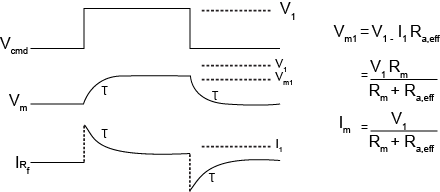
What is continuous single electrode voltage-clamp (cSEVC)?
Continuous single electrode voltage-clamp (cSEVC) is an electrophysiological patch-clamping method to pass a membrane voltage into a cell and measure the change in current as the voltage steps. In cSEVC, the same electrode is used simultaneously for voltage recording and for current passing. The cSEVC circuit is illustrated as a voltage source (Vcmd) in series with the effective access resistance (Ra.eff) and the membrane (Rm, Cm). The cSEVC circuit ensures that the pipette potential (Vp) is equal to Vcmd.

After Vcmdsteps to V1, a stead-state current (Im) flows in the circuit. The membrane potential is equal to Vcmd- ImRa,eff. After the step change in the command potential, Imand Vmsettle exponentially to their steady state values with the time constant τ. In general, Rm>> Ra,eff, a good approximation is τ ≈ Ra,effCm.

For more information, please download our Axon Guide.
Other links: